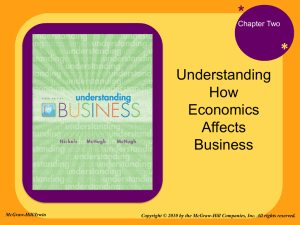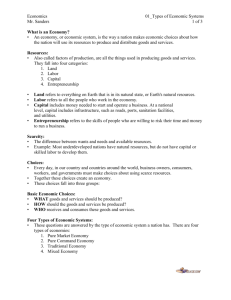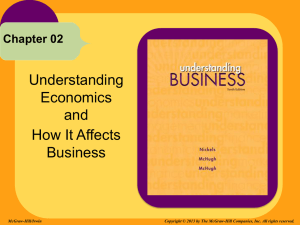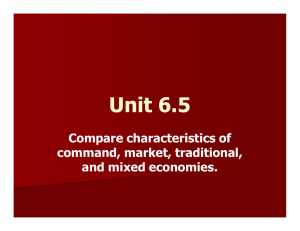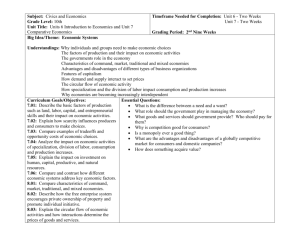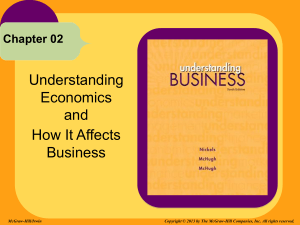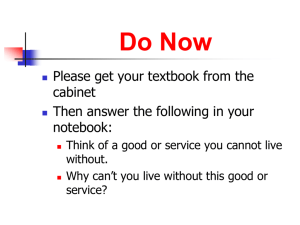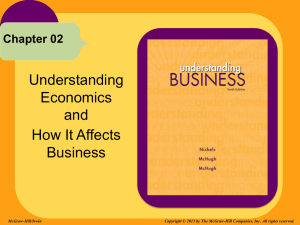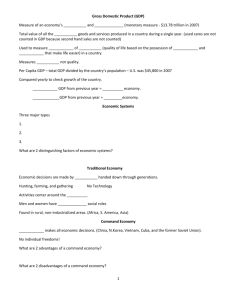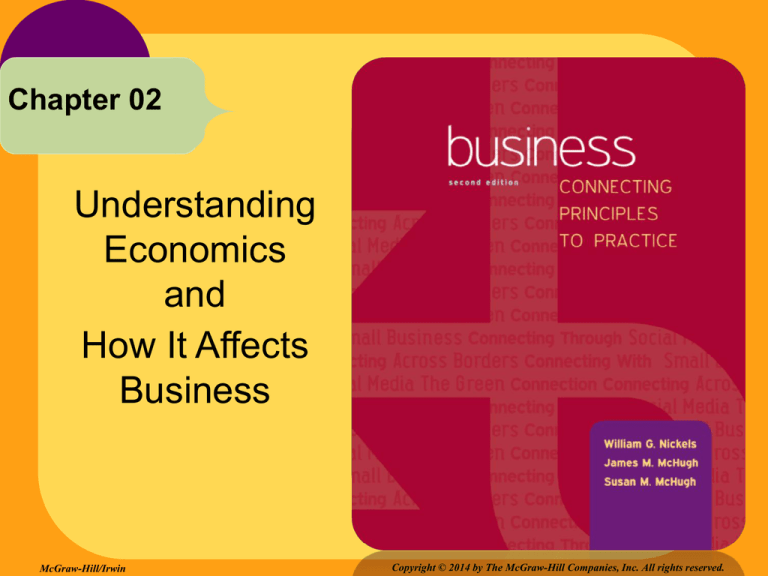
Chapter 02
Understanding
Economics
and
How It Affects
Business
McGraw-Hill/Irwin
Copyright © 2014 by The McGraw-Hill Companies, Inc. All rights reserved.
Chapter Two
LEARNING GOALS
1.
Explain basic economic; what capitalism is and how free
markets work.
2.
Analyze the trend toward mixed economies.
3.
Describe the economic system of the U.S., including the
significance of key economic indicators (especially GDP),
productivity and the business cycle.
4.
Contrast fiscal policy and monetary policy, and explain how
each affects the economy.
5.
Contrast Caitalism, Socialism, Communisim and mixed markets.
2-2
Profile
JOHN MAYNARD KEYNES
• Had great influence on U.S. economic policy.
• Believed if the economy was in a recession, the
government should increase spending and cut
taxes to stimulate the economy for a short term.
• Wrote The General
Theory of Employment,
Interest and Money in
1936.
2-3
What Is
Economics?
LG1
The MAJOR BRANCHES of
ECONOMICS
• Economics -- The study of how society employs
resources to produce goods and services for
consumption among various groups and individuals.
• Macroeconomics -- Concentrates on the
operation of a nation’s economy as a whole.
• Microeconomics -- Concentrates on the behavior
of people and organizations in markets for particular
products or services.
2-4
What Is
Economics?
RESOURCE DEVELOPMENT
LG1
• Resource
Development -The study of how to
increase resources
and create
conditions that will
make better use of
them.
2-5
What Is
Economics?
LG1
EXAMPLES of WAYS to
INCREASE RESOURCES
• New energy sources
– Hydrogen fuel
• New ways of growing
foods
– Hydroponics
• New ways of creating
goods and services
– Aquaculture
– Nanotechnology
2-6
The Secret to
Creating a
Wealthy
Economy
LG1
THOMAS MALTHUS and
the DISMAL SCIENCE
• Malthus believed that if the rich had most of the
wealth and the poor had most of the population,
resources would run out.
• This belief led the writer Thomas Carlyle to call
economics “The Dismal Science.”
• Neo-Malthusians believe there are too many
people in the world and believe the answer is
radical birth control.
2-7
The Secret to
Creating a
Wealthy
Economy
POPULATION as a RESOURCE
LG1
• Contrary to Malthus, some
economists believe a large
population can be a resource.
- An educated population is
highly valuable.
- Business owners provide jobs
and economic growth for their
employees and communities
as well as for themselves.
2-8
BRINGING in the GREEN
with GREEN PRODUCTS
(Thinking Green)
• The public’s concern with
global warming contributed to
the success of the Toyota
Prius.
• Farmers are growing more
corn and other crops to use
for biofuels.
• What can you do to help
lower carbon emissions?
Photo courtesy of Toyota UK
2-9
Adam Smith &
the Creation of
Wealth
LG1
ADAM SMITH the
FATHER of ECONOMICS
Smith believed that:
• Freedom was vital to any economy’s survival.
• Freedom to own land or
property and the right to
keep the profits of a
business is essential.
• People will work hard if
they believe they will be
rewarded.
• The Invisible Hand Theory
2-10
How Businesses
Benefit the
Community
LG1
UNDERSTANDING the
INVISIBLE HAND THEORY
• A farmer earns money by
selling his crops.
• To earn more, the farmer hires
farmhands to produce more
crops.
• When the farmer produces
more, there is plenty of food
for the community.
• The farmer helped his
employees and his community
while helping himself.
2-11
Understanding
Free-Market
Capitalism
CAPITALISM
LG2
• Capitalism -- All or most of the land, factories and
stores are owned by individuals, not the
government, and operated for profit.
• Countries with
capitalist foundations:
- United States
- England
- Australia
- Canada
- State Capitalism -- When
the state, rather than
private owners, run some
businesses.
2-12
The Foundations
of Capitalism
LG2
CAPITALISM’S
FOUR BASIC RIGHTS
1. The right to own private
property.
2. The right to own a business
and keep all that business’s
profits.
3. The right to freedom of
competition.
4. The right to freedom of
choice.
2-13
The Foundations
of Capitalism
LG2
ROOSEVELT’S FOUR
ADDITIONAL RIGHTS
1. Freedom of speech and
expression.
2. Freedom to worship in your
own way.
3. Freedom from want.
4. Freedom from fear.
2-14
How Free
Markets Work
FREE MARKETS
LG2
• Free Market -- Decisions about what and how
much to produce are made by the market.
• Consumers send signals about what they like
and how they like it.
• Price tells companies how much of a product
they should produce.
• If something is wanted but hard to get, the price
will rise until more products are available.
2-15
How Prices are
Determined
PRICING
LG2
• A seller may want to sell
shirts for $50, but only a
few people may buy them
at that price.
• If the seller lowers the
price to $30, more people
buy the shirts.
• The seller establishes a
price of $30 based on what
consumers are willing to
pay.
2-16
The Economic
Concept of
Supply
SUPPLY CURVES
LG2
• Supply -- The quantities of products businesses are
willing to sell at different prices.
• Demand -- The quantities of products consumers
are willing to buy at different prices.
• Market Price (Equilibrium Point) -- Determined
by supply and demand, this is the negotiated price
2-17
Competition
Within Free
Markets
LG2
FOUR DEGREES
of COMPETITION
1. Perfect
Competition
2. Monopolistic
Competition
3. Oligopoly
4. Monopoly
2-18
Benefits and
Limitations of
Free Markets
FREE MARKET BENEFITS
and LIMITATIONS
Benefits:
• It allows for open
competition among
companies.
• Provides opportunities for
poor people to work their
way out of poverty.
Limitations:
• People may start to let
greed drive them.
2-19
Understanding
Socialism
SOCIALISM
LG3
• Socialism -- An economic system based on the
premise that some basic businesses, like utilities,
should be owned by the government in order to more
evenly distribute profits among the people.
• Entrepreneurs run smaller businesses.
• Citizens are highly taxed.
• Government is more involved in protecting the
environment and the poor.
• Benefits and Negatives of Socialism
2-20
Understanding
Communism
COMMUNISM
LG3
• Communism -- An economic and political system in
which the government makes almost all economic
decisions and owns almost all the major factors of
production.
• Prices don’t reflect demand which may lead to
shortages of items, including food and clothing.
• Most communist countries today suffer severe
economic depression and citizens fear the
government.
2-21
The Trend
Toward Mixed
Economies
LG4
TWO MAJOR
ECONOMIC SYSTEMS
• Free-Market Economies -- The market largely determines what
goods and services are produced, who gets them, and how the
economy grows.
• Command Economies -- The government largely determines
what goods and services are produced, who gets them, and how
the economy will grow.
• Mixed Economies -- Some allocation of resources is made by
the market and some by the government.
• Neither free-market nor command economies have created
sound economic conditions so countries use a mix of the two
economic systems
2-22
The Trend
Toward Mixed
Economies
LG4
TRENDING TOWARD MIXED
ECONOMIES
• Communist governments are disappearing.
• Socialist governments
are cutting back on social
programs, lowering taxes
and moving toward
capitalism.
• Capitalist countries are
increasing social
programs and moving
more toward socialism.
2-23
CHINA’S
CHANGING ECONOMY
(Reaching Beyond Our Borders)
• China’s economy is growing two or three times faster
than the U.S.
• China is worried about inflation and a possible
housing crash.
• Though known for its
socialist and
communist
foundations, the
adoption of capitalist
principles is credited
for some of the growth.
2-24
Key Economic
Indicators
GROSS DOMESTIC PRODUCT
LG5
• Gross Domestic Product (GDP) -- Total value of
final goods and services produced in a country in a
given year. As long as a company is within a
country’s border, their numbers go into the
country’s GDP (even if they are foreign-owned).
• When the GDP changes, businesses feel the
effect.
• The high U.S. GDP (about $14 trillion) is what
enables us to enjoy a high standard of living.
2-25
Key Economic
Indicators
The UNITED STATES GDP
LG5
Source: World Bank , www.worldbank.org, accessed June 2011.
2-26
Key Economic
Indicators
UNEMPLOYMENT
LG5
• Unemployment Rate -- The percentage of
civilians at least 16-years-old who are unemployed
and tried to find a job within the prior four weeks.
• Four Types of
Unemployment
1.
2.
3.
4.
Frictional
Structural
Cyclical
Seasonal
2-27
Key Economic
Indicators
INFLATION
LG5
• Inflation -- The general rise in the prices of goods
and services over time.
• Disinflation -- When the price increases are slowing
(inflation rate declining).
• Deflation -- Prices are declining because too few
dollars are chasing too many goods.
• Stagflation -- Economy is slowing, but prices are
going up.
2-28
Key Economic
Indicators
PRICE INDECES
LG5
• Consumer Price Index (CPI) -- Monthly statistics that
measure the pace of inflation or deflation.
•
The government computes the costs of goods and services
(housing, food, apparel, medical care, etc.) to see if they are going
up or down.
•
The wages, rent/leases, tax brackets, government benefits and
interest rates of some citizens are based upon the CPI.
• Producer Price Index (PPI) -- An index that
measures prices at the wholesale level.
2-29
Productivity in
the United States
PRODUCTIVITY
LG5
• Productivity in the U.S. has risen due to the
technological advances that have made
production faster and easier.
• Productivity in the
service sector grows
more slowly because
of fewer
technologies.
2-30
Productivity in
the Service
Sector
LG5
PRODUCTIVITY in the
SERVICE SECTOR
• The higher the productivity, the lower the costs of
producing goods and services. This helps lower
prices.
• New technology adds to the quality of the
services provided, but not to the worker’s output.
• A new form of measurement needs to be created
to account for the quality as well as the quantity
of output.
2-31
The Business
Cycle
BUSINESS CYCLES
LG5
• Business Cycles -- Periodic rises and falls that
occur in economies over time.
• Four Phases of Long-Term Business Cycles:
1. Economic Boom
2. Recession – Two or more consecutive quarters
of decline in the GDP.
3. Depression – A severe recession.
4. Recovery – When the economy stabilizes and
starts to grow. This leads to an Economic Boom.
2-32
Stabilizing the
Economy Through
Fiscal Policy
LG6
FISCAL POLICY
• Fiscal Policy -- The federal
government’s efforts to keep the
economy stable by increasing or
decreasing taxes or government
spending.
• Tools of Fiscal Policy:
Taxation
Government Spending
•
National Deficit -- The amount of money the
federal government spends beyond what it
gathers in taxes.
•
National Debt -- The sum of government
deficits over time.
•
National Surplus -- When government takes
in more than it spends.
2-33
Using Monetary
Policy to Keep the
Economy Growing
MONETARY POLICY
LG6
• Monetary Policy -- The management of the
money supply and interest rates by the Federal
Reserve Bank (the Fed).
• The Fed’s most visible role is increasing and
lowering interest rates.
- When the economy is booming, the Fed tends to
increase interest rates.
- When the economy is in a recession, the Fed
tends to decrease the interest rates.
2-34


